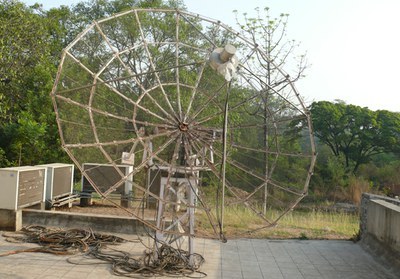4-m Small Meterwave Radio Telescope (SMRT)

Control System, Receivers Software (Links releasing shortly)
The radio telescope facility at RPL is an excellent pedagogical tool for introducing students to the field of radio astronomy. The 4-m Small Meterwave Radio Telescope (SRT) antenna is a locally fabricated antenna with drive systems and receivers and has been the main workhorse of RPL since 2006. This antenna is located in the north end of NCRA East campus with the control-room (Room No 6) just in front of the antenna. The telescope can look approximately 70% of the sky above horizon. The antenna can rotate in two directions - azimuth (AZ) and altitude (AL ). Both the rotation axes are controlled by two Baldor brushless DC motors driven using Delta-tau drives, which are operated through a program running on a local PC. Both the motions can be achieved by giving precise position and velocity commands. Both axes are equipped with incremental encoders which provide the position information. The receiver consists of a 21-cm horn, mounted on a quadripod above the dish. The RF signal is amplified using a 35 K LNA and is fed to a RAS 21-cm receiver (superheterodyne swept local oscillator receiver). The receiver can be operated in two modes - continuum and spectral line mode. The former is used for experiments with the Sun and other strong radio sources. The latter mode is used for HI observations of our Galaxy. The SRT is used routinely for simple radio astronomy experiments involving observations of Sun and the Galaxy.
